2014苏教版英语三上期末字母、单词复习卷
- 格式:doc
- 大小:34.00 KB
- 文档页数:2
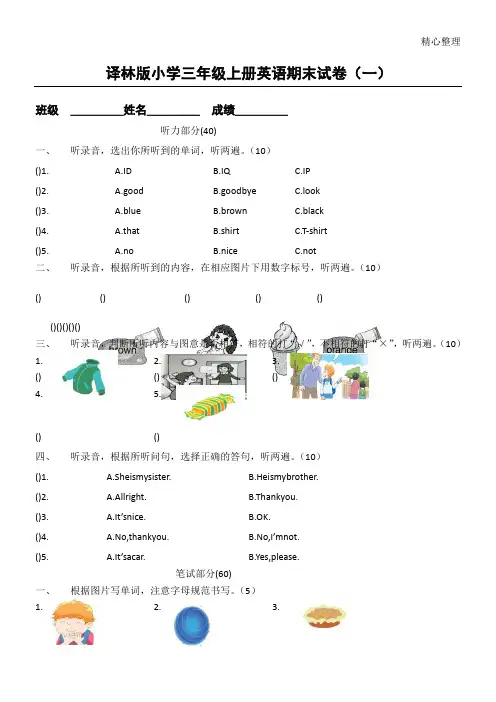
精心整理译林版小学三年级上册英语期末试卷(一)班级 _________姓名_________ 成绩_________听力部分(40)一、 听录音,选出你所听到的单词,听两遍。
(10)()1. A.ID B.IQ C.IP ()2. A.good B.goodbye C.look ()3. ()4. ()5. 二、 ()三、 听录音,判断所听内容与图意是否相符,相符的打“√”,不相符的打“×”(10)1. 2. 3. () () ()4.5.() ()四、 听录音,根据所听问句,选择正确的答句,听两遍。
()1. ()2. ()3. A.It ’snice. B.OK. ()4. A.No,thankyou. B.No,I ’mnot. ()5. A.It ’sacar.B.Yes,please.笔试部分(60)一、 根据图片写单词,注意字母规范书写。
(5)1.2.3.4. 5.二、英汉互译。
(10)1.3.5.7.9.三、()1.()2.()3.()4.()5.四、()1.()2.()3. ----What’sthis?----It’san______car.A.orangeB.blueC.green()4. ----ThisisSam.----__________.A.Nicetomeetyou.B.Goodmorning.C.Goodbye.()5. ----_____________----Yes,please.A.Whataboutapie?B.Whatdoyoulike?C.AreyouLiuTao?五、匹配题。
(10)()1. Lookatmyskirt. A.It’sorange.()2. Thiscakeisforyou. B.It’sabluecat.()3. HappyNewYear. C.Thankyou.()4. Whatcolourisit? D.HappyNewYear.()5. What’sthis? E.Great.六、根据情景,选择合适的句子。
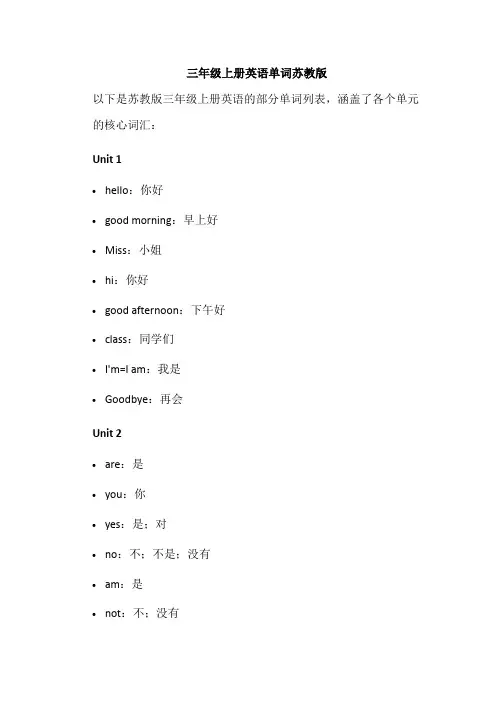
三年级上册英语单词苏教版以下是苏教版三年级上册英语的部分单词列表,涵盖了各个单元的核心词汇:Unit 1•hello:你好•good morning:早上好•Miss:小姐•hi:你好•good afternoon:下午好•class:同学们•I'm=I am:我是•Goodbye:再会Unit 2•are:是•you:你•yes:是;对•no:不;不是;没有•am:是•not:不;没有•goodbye:再见Unit 3•my:我的•friend:朋友•she:她•she's=she is:她是•he:他•he's=he is:他是•too:也•this:这;这个•is:是•sister:姐姐;妹妹Unit 4•family:家;家庭•father:父亲;爸爸•mother:母亲;妈妈•brother:哥哥;弟弟•me:我•grandpa:祖父;外祖父•grandma:祖母;外祖母•good evening:晚上好Unit 5•look at:看;瞧•T-shirt:T恤衫•it:它•it's=it is:它是•nice:好看的;好的•skirt:裙子•How nice!:真好看!•cap:便帽;帽子•great:好极了;很好•jacket:夹克衫•new:新的•What colour…?:…是什么颜色的?•red:红色的Unit 6•colour:颜色•orange:橙色的•now:现在;目前•green:绿色的•and:和;与;又•yellow:黄色的•black:黑色的•blue:蓝色的•brown:棕色的•white:白色的•Would you like…?:你想要……吗?•an:一个•egg:蛋;鸡蛋•Yes, please.:好的,太感谢了。
•or:或;还是Unit 7•pie:馅饼;派•Nice to meet you.:很高兴认识你•No, thank you.:不,谢谢•What about…?:怎么样?•cake:蛋糕•ice cream:冰淇淋•sweet:糖果•hot dog:热狗•look:看;瞧•what:什么•what's=what is:是什么Unit 8•Happy New Year!:新年快乐!•uncle:叔父;伯父;舅父;姑父;姨父•This is for you.:这是给你的。
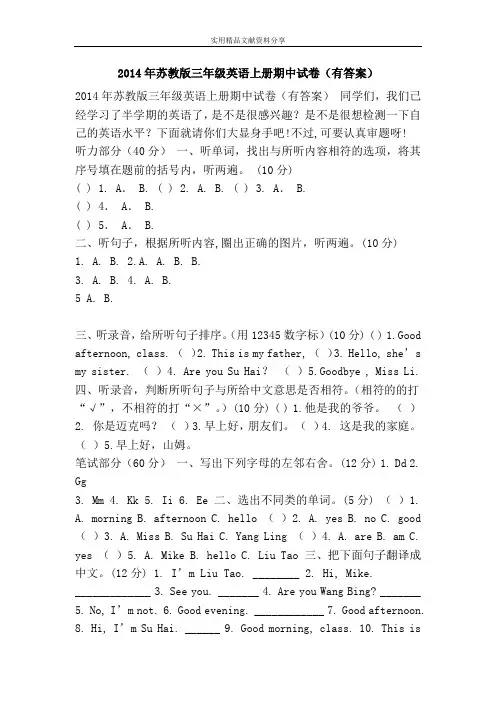
2014年苏教版三年级英语上册期中试卷(有答案)2014年苏教版三年级英语上册期中试卷(有答案)同学们,我们已经学习了半学期的英语了,是不是很感兴趣?是不是很想检测一下自己的英语水平?下面就请你们大显身手吧!不过,可要认真审题呀!听力部分(40分)一、听单词,找出与所听内容相符的选项,将其序号填在题前的括号内,听两遍。
(10分)( ) 1. A. B. ( ) 2. A. B. ( ) 3. A. B.( ) 4. A. B.( ) 5. A. B.二、听句子,根据所听内容,圈出正确的图片,听两遍。
(10分)1. A. B.2.A. A. B. B.3. A. B.4. A. B.5 A. B.三、听录音,给所听句子排序。
(用12345数字标)(10分) ( ) 1.Good afternoon, class. ()2. This is my father, ()3. Hello, she’s my sister. ()4. Are you Su Hai?()5.Goodbye , Miss Li.四、听录音,判断所听句子与所给中文意思是否相符。
(相符的的打“√”,不相符的打“×”。
)(10分) ( ) 1.他是我的爷爷。
()2. 你是迈克吗?()3.早上好,朋友们。
()4. 这是我的家庭。
()5.早上好,山姆。
笔试部分(60分)一、写出下列字母的左邻右舍。
(12分) 1. Dd 2. Gg3. Mm4. Kk5. Ii6. Ee 二、选出不同类的单词。
(5分) ()1.A. morningB. afternoonC. hello ()2. A. yes B. no C. good ()3. A. Miss B. Su Hai C. Yang Ling ()4. A. are B. am C. yes ()5. A. Mike B. hello C. Liu Tao 三、把下面句子翻译成中文。
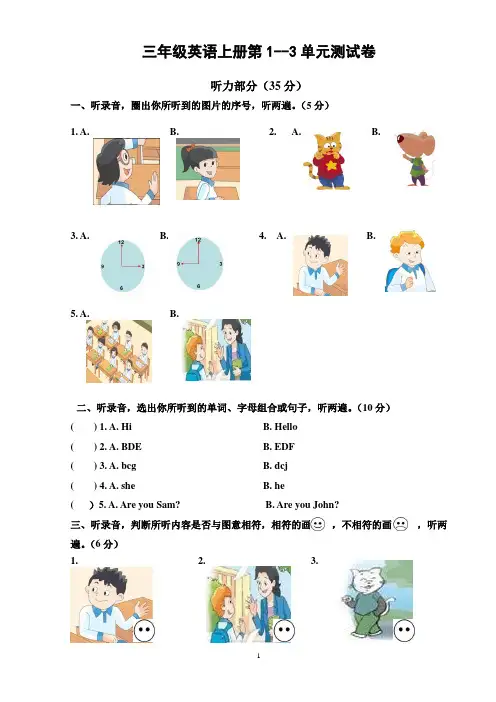
三年级英语上册第1--3单元测试卷听力部分(35分)一、听录音,圈出你所听到的图片的序号,听两遍。
(5分)1. A. B.2. A. B.3. A. B.4. A. B.5. A. B.二、听录音,选出你所听到的单词、字母组合或句子,听两遍。
(10分)( ) 1. A. Hi B. Hello( ) 2. A. BDE B. EDF( ) 3. A. bcg B. dcj( ) 4. A. she B. he( )5. A. Are you Sam? B. Are you John?三、听录音,判断所听内容是否与图意相符,相符的画,不相符的画,听两遍。
(6分)1. 2. 3.4. 5. 6.四、听录音,选出正确的应答,听两遍。
(6分)( ) 1. A. Good morning. B. Good afternoon.( ) 2. A. Hello, Bobby. B. Hello, I’m Bobby.( ) 3. A. Yes, I am. B. Yes, I’m not.( ) 4. A. Hi, I’m Sam. B. Hi, Sam.( ) 5. A. Goodbye, class. B. Goodbye, Miss Li.五、听写字母组合, 听两遍.。
(8分)大写: 1. 2. 3. 4.小写: 1. 2 3. 4.笔试部分(65分)一、连线找朋友。
(5分)1.I’m Liu Tao. A.你是王兵吗?2.Goodbye. B.我是刘涛。
3.Are you Wang Bing? C. 不,我不是。
4.You’re right. D. 再见。
5.No, I’m not. E. 你答对了。
二、写出下列字母的左邻右舍,注意大小写(18分)1.L2.M3. J4. i5. X6. d7. c8. f9. G三、选择适当的答案,将序号填在括号里。
(9分)( ) 1. ________ my sister, Tina.A. She’sB. He’s( ) 2. Hi, ______ Liu Tao.A. I’mB. this( ) 3. _______ Su Hai?A. She’sB. Are you( ) 4 . —Good morning, Mike.—_____________.A. Good evening, Mum.B. Good morning, Mum.( ) 5. —Hello, are you Mike?—Yes, _______.A. I’m notB. I am( )6 . —— No, I’m not.I’m Liu Tao.A. Hello, Liu Tao.B. Are you Wang Bing?( )7 . —This is my sister, Tina.—.A. Hi ,Tina.B. Goodbye, Tina.( )8.—Yang Ling. my friend.A. She’s;He’sB. She’s;She’s( )9.—Hi ,Bobby.—.A、Hi , I’m Sam.B、Good morning.C、I am, Sam.四、翻译下列短语或句子。
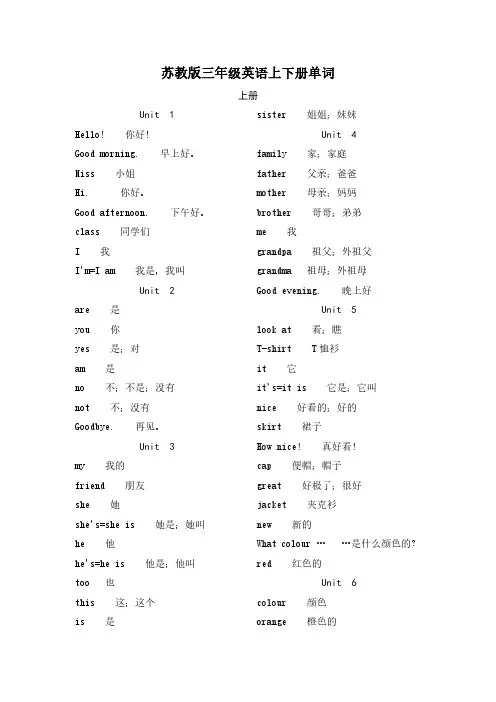
苏教版三年级英语上下册单词上册Unit1Hello!你好!Good morning.早上好。
Miss小姐Hi.你好。
Good afternoon.下午好。
class同学们I我I'm=I am我是,我叫Unit2are是you你yes是;对am是no不;不是;没有not不;没有Goodbye.再见。
Unit3my我的friend朋友she她she's=she is她是;她叫he他he's=he is他是;他叫too也this这;这个is是sister姐姐;妹妹Unit4family家;家庭father父亲;爸爸mother母亲;妈妈brother哥哥;弟弟me我grandpa祖父;外祖父grandma祖母;外祖母Good evening.晚上好Unit5look at看;瞧T-shirt T恤衫it它it's=it is它是;它叫nice好看的;好的skirt裙子How nice!真好看!cap便帽;帽子great好极了;很好jacket夹克衫new新的What colour……是什么颜色的?red红色的Unit6colour颜色orange橙色的now现在;目前green绿色的and和;与;又yellow黄色的black黑色的blue蓝色的brown棕色的white白色的Would you like…?你想要…吗?an一个egg蛋;鸡蛋yes,please好的,太感谢了or或;还是Unit7a一个pie馅饼Nice to meet you很高兴认识你No,thank you.不,谢谢你What about…?…怎么样?cake蛋糕;糕饼ice cream冰淇淋sweet糖果hot dog热狗look看;瞧what什么what's=what is什么是Unit8Happy New Year!新年快乐!uncle叔父;伯父;姑父This is for you.这是给你的doll玩具娃娃that那;那个ball球CD光盘robot机器人car小汽车;轿车Happy Birthday!生日快乐!toy玩具ah啊ha哈下册Unit1in class在上课stand up起立Mr先生Sit down.坐下please请open开;打开the这个;这些;那个;那些door门sorry对不起come in进来close关上;合上window窗,窗户blackboard黑板book书rubber橡皮don't=do not listen to听parrot鹦鹉Unit2 In在……里library图书馆Shh嘘shout喊;叫run跑;跑步eat吃here这里;在这里talk说话;谈话sleep睡觉drink喝milk牛奶English英语your你的,你们的Unit3 pencil铅笔isn’t=is notthat's=that is schoolbag书包pen钢笔crayon蜡笔ruler尺pencil case铅笔盒lunch box午餐盒where在哪里Where’s=where is over there在那里Unit4bird鸟beautiful漂亮的;美丽的under在……下面desk课桌;书桌behind在……的后面on在……上面chair椅子tree树guess猜;猜测one一two二three三oh哦,啊wow哇,呀Unit5how old are you你多大?lovely可爱的nine九eight八four四five五six六seven七ten十right对的;正确的out出局What a nice cake!多么漂亮的蛋糕啊!Make a wish.许个愿吧。
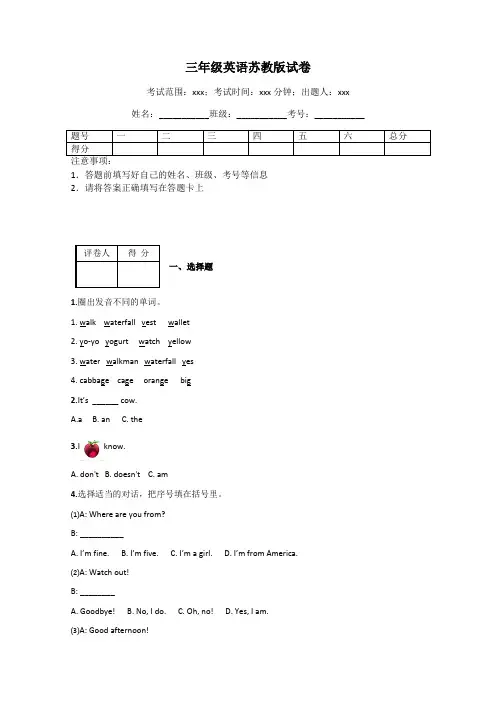
三年级英语苏教版试卷考试范围:xxx;考试时间:xxx分钟;出题人:xxx姓名:___________班级:___________考号:___________1.答题前填写好自己的姓名、班级、考号等信息2.请将答案正确填写在答题卡上一、选择题1.圈出发音不同的单词。
1. walk waterfall vest wallet2. yo-yo yogurt watch yellow3. water walkman waterfall yes4. cabbage cage orange big2.It’s ______ cow.A.aB. anC. the3.I know.A. don'tB. doesn'tC. am4.选择适当的对话,把序号填在括号里。
⑴A: Where are you from?B: __________A. I’m fine.B. I’m five.C. I’m a girl.D. I’m from America.⑵A: Watch out!B: ________A. Goodbye!B. No, I do.C. Oh, no!D. Yes, I am.⑶A: Good afternoon!B: ________A. Thank you.B. Fine, thank you.C. Good afternoon!D. Great!⑷A: Happy Women’s Day!B: ________A. Yes.B. Thank you.C. Come in.D. It’s OK!⑸A: _________B: It’s OK.A. This is Sarah.B. Nice to meet you!C. I’m sorry.D. My name is Amy.5.( )(3)妈妈给你买蛋糕,你说:A. Great, thank you.B. A pink flower.6.()Can I you a questionA. askB. asksC. asking7.How many do you see?()A、kitesB、a kite8.照例子,选一选。
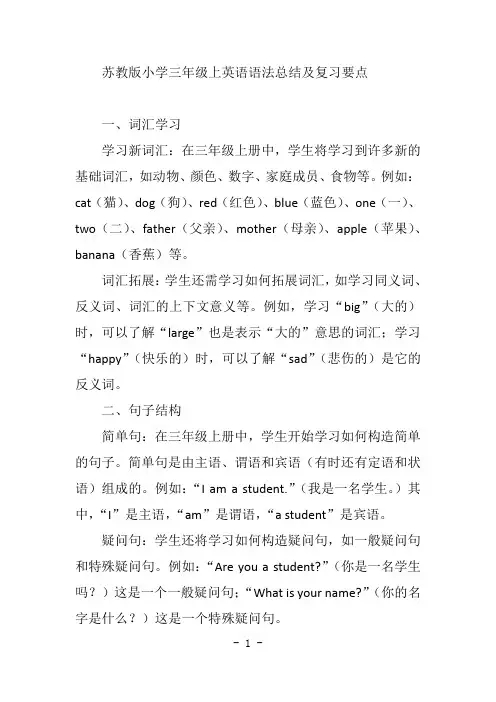
苏教版小学三年级上英语语法总结及复习要点一、词汇学习学习新词汇:在三年级上册中,学生将学习到许多新的基础词汇,如动物、颜色、数字、家庭成员、食物等。
例如:cat(猫)、dog(狗)、red(红色)、blue(蓝色)、one(一)、two(二)、father(父亲)、mother(母亲)、apple(苹果)、banana(香蕉)等。
词汇拓展:学生还需学习如何拓展词汇,如学习同义词、反义词、词汇的上下文意义等。
例如,学习“big”(大的)时,可以了解“large”也是表示“大的”意思的词汇;学习“happy”(快乐的)时,可以了解“sad”(悲伤的)是它的反义词。
二、句子结构简单句:在三年级上册中,学生开始学习如何构造简单的句子。
简单句是由主语、谓语和宾语(有时还有定语和状语)组成的。
例如:“I am a student.”(我是一名学生。
)其中,“I”是主语,“am”是谓语,“a student”是宾语。
疑问句:学生还将学习如何构造疑问句,如一般疑问句和特殊疑问句。
例如:“Are you a student?”(你是一名学生吗?)这是一个一般疑问句;“What is your name?”(你的名字是什么?)这是一个特殊疑问句。
三、时态一般现在时:在三年级上册中,学生开始学习一般现在时,这是描述经常发生或习惯性的动作的时态。
例如:“I usually go to school at 7:00.”(我通常7:00去学校。
)四、语法点详解名词的单复数:学生需要学习名词的单数和复数形式,并了解如何在句子中正确使用。
例如,cat(猫)的复数是cats (猫们);apple(苹果)的复数是apples(苹果们)。
冠词使用:学生将学习定冠词“the”和不定冠词“a/an”的使用,了解它们在句子中的作用。
例如:“The cat is playing with the ball.”(猫正在玩球。
)在这个句子中,“the”用于修饰单数名词,表示这个名词是特指的。
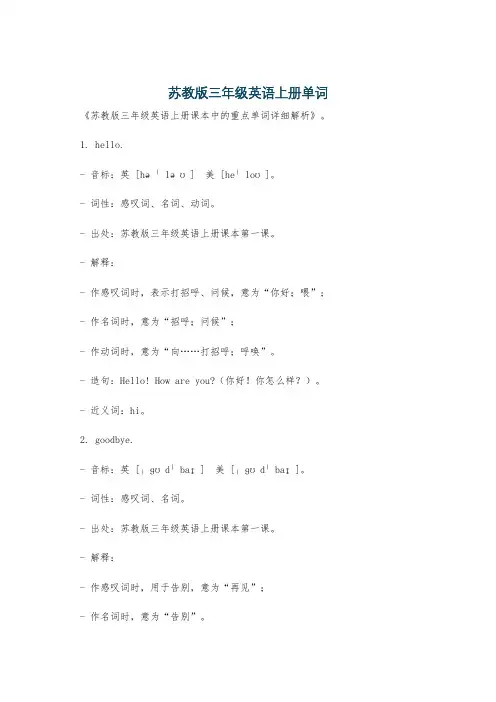
苏教版三年级英语上册单词《苏教版三年级英语上册课本中的重点单词详细解析》。
1. hello.- 音标:英 [həˈləʊ] 美 [heˈloʊ]。
- 词性:感叹词、名词、动词。
- 出处:苏教版三年级英语上册课本第一课。
- 解释:- 作感叹词时,表示打招呼、问候,意为“你好;喂”;- 作名词时,意为“招呼;问候”;- 作动词时,意为“向……打招呼;呼唤”。
- 造句:Hello! How are you?(你好!你怎么样?)。
- 近义词:hi。
2. goodbye.- 音标:英 [ˌɡʊdˈbaɪ] 美 [ˌɡʊdˈbaɪ]。
- 词性:感叹词、名词。
- 出处:苏教版三年级英语上册课本第一课。
- 解释:- 作感叹词时,用于告别,意为“再见”;- 作名词时,意为“告别”。
- 造句:Goodbye! See you later.(再见!待会儿见。
)。
- 近义词:bye。
3. I.- 音标:英 [aɪ] 美 [aɪ]。
- 词性:代词。
- 出处:苏教版三年级英语上册课本第一课。
- 解释:主格形式的第一人称单数,意为“我”。
- 造句:I am a student.(我是一名学生。
)。
4. am.- 音标:英 [əm] 美 [əm]。
- 词性:动词。
- 出处:苏教版三年级英语上册课本第一课。
- 解释:be动词的第一人称单数现在时形式,用于构成一般现在时的肯定句和疑问句,意为“是”。
- 造句:I am happy.(我很高兴。
)。
5. you.- 音标:英 [juː] 美 [jə]。
- 词性:代词。
- 出处:苏教版三年级英语上册课本第一课。
- 解释:第二人称主格和宾格形式,意为“你;你们”。
- 造句:You are my friend.(你是我的朋友。
)。
6. yes.- 音标:英 [jes] 美 [jes]。
- 词性:副词。
- 出处:苏教版三年级英语上册课本第一课。
- 解释:用于对问题作出肯定回答,意为“是的”。
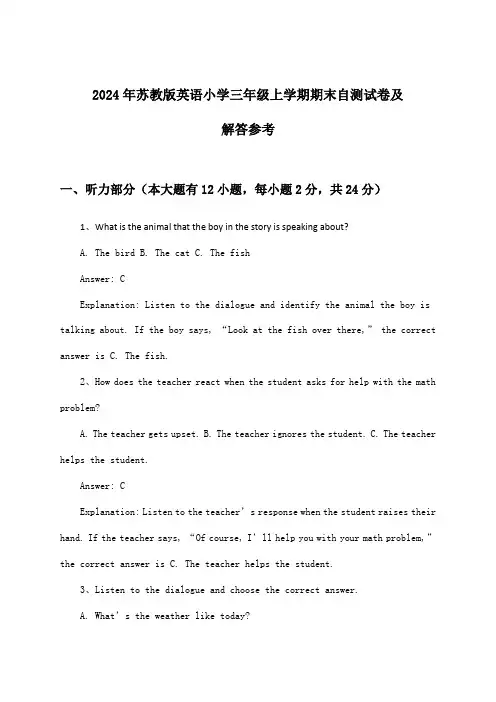
2024年苏教版英语小学三年级上学期期末自测试卷及解答参考一、听力部分(本大题有12小题,每小题2分,共24分)1、What is the animal that the boy in the story is speaking about?A. The birdB. The catC. The fishAnswer: CExplanation: Listen to the dialogue and identify the animal the boy is talking about. If the boy says, “Look at the fish over there,” the correct answer is C. The fish.2、How does the teacher react when the student asks for help with the math problem?A. The teacher gets upset.B. The teacher ignores the student.C. The teacher helps the student.Answer: CExplanation: Listen to the teacher’s response when the student raises their hand. If the teacher says, “Of course, I’ll help you with your math problem,”the correct answer is C. The teacher helps the student.3、Listen to the dialogue and choose the correct answer.A. What’s the weather like today?B. It’s sunny and warm.C. It’s going to rain later.Answer: BExplanation: The question asks about the weather, and the correct answer is provided in the dialogue as “It’s sunny and warm.”4、Listen to the story and answer the question.Question: Who is the main character in the story?A. The catB. The dogC. The boyAnswer: CExplanation: The story mentions a boy as the main character, so the correct answer is the boy.5、听力原文:W: What is your name?M: My name is Li Ming. And you?Q: What is the name of the boy?答案:Li Ming解析:本题中,男孩自我介绍说他叫Li Ming,所以答案为Li Ming。
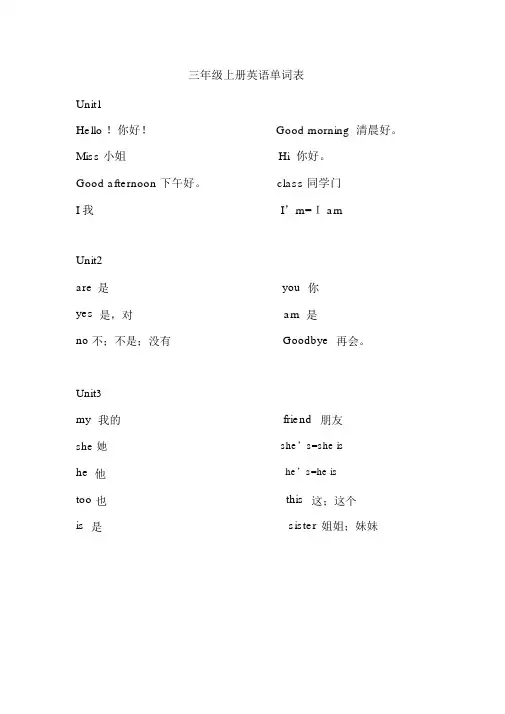
三年级上册英语单词表Unit1Hello !你好!Good morning 清晨好。
Miss 小姐Hi 你好。
Good afternoon 下午好。
class 同学门I 我I’m=I amUnit2are yes 是是,对youam你是no不;不是;没有Goodbye再会。
Unit3my我的friend朋友she 她she’s=she ishe他he’s=he istoo也this这;这个is是sister姐姐;妹妹Unit4family 家;家庭father 父亲;爸爸mother 母亲;妈妈brother 哥哥;弟弟me 我grandpa 祖父;外祖父grandma 祖母;外祖母Good evening 夜晚好。
Unit5look at看;瞧T-shirt T 恤衫it它it ’s=it isnice漂亮的;好的skirt裙子How nice !真漂亮!cap 便帽;帽子great好极了;很好jacket夹克衫new新的What colour?red红色的是什么颜色的?Unit6colour 颜色orange橙色的now此刻;当前green绿色的and和;与;又yellow黄色的black黑色的blue 黑色的brown 棕色的white 白色的Would you like ?an 一个你想要吗?egg蛋;鸡蛋Yes, please好的,太感谢了。
or或;仍是Unit7a 一个pie 馅饼;派Nice to meet you No ,thank you不,感谢你很快乐认识你。
What about ?怎么样?cake 蛋糕;糕饼ice cream 冰激凌sweet 糖果hot dog 热狗look 看;瞧what 什么what ’s=what isUnit8Happy New Year!新年快乐!uncle叔父;伯父;舅舅;This is for you doll 玩具娃娃ball 球这是给你的姑父;姨父that 那;那个robot 机器人CD光盘car小汽车;轿车Happy Birthday!诞辰快乐!toy玩具ah啊ha哈。
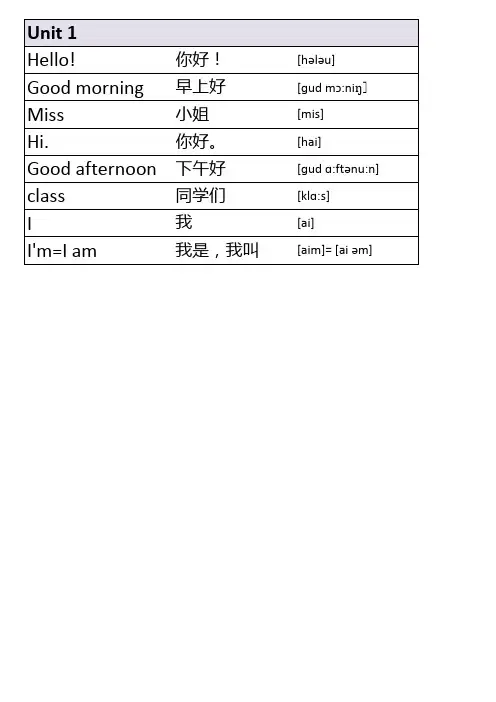
苏教版三年级英语3A知识练习第一单元:一、单词:二、课文:三、知识点详解:1. 与别人打招呼可以说Hi. / Hello! 介绍自己要说I’m。
2. 单词Miss是小姐的意思,指的是未婚的女士,通常出现在姓氏的前面。
在学校称呼未婚的女老师可以用Miss,比如说Miss Wang,Miss Zhang。
称呼已婚的女老师应用Mrs.(夫人)而称呼男老师应用Mr.(先生)3. 字母的大写:在英语中,每一句话是以句号,问号和感叹号结束的。
每一句话的第一个字母都必须要大写。
单词I(我)必须大写。
另外,人名字的第一个字母也要大写,比如Mike。
对人的称谓的第一个字母也需要大写,比如Miss。
四、单元小测验。
A. 连一连。
1. Good morning, Mike. 你好,迈克。
2. Good afternoon, Miss Li. 早上好,李老师。
3. Hello, Mike. 早上好,迈克。
4. Good morning, Miss Li. 同学们,下午好。
5. Good afternoon, class. 下午好,李老师。
B. 情景选择。
()1. 你和好朋友王兵打招呼说:()2. 早上,在校园里你遇到了李老师,你说:()3. 下午,李老师和同学们打招呼说:()4. 你告诉别人你叫迈克,你说:A. Good morning, Miss Li.B. Good afternoon, class.C. Hello, Wang Bing.D. Hi, I’m Mike.C. 看图,选择并圈出合适的句子。
A. Good morning.B. Good afternoon.A. Good morning.B. Good afternoon.A. Hello, I’m Bobby.B. Hi, I’m Sam.A. Good afternoon, Miss Li.B. Good afternoon, class.D. 连词成句第二单元:一、单词:are 是you 你yes 是;对am 是no 不;不是;没有not 不;没有Goodbye. 再见二、课文:三、知识点详解:1. 单词Hi除了有和别人打招呼的含义外,还有引起别人注意的意思。
英语三年级上学期字母、单词复习卷
一、按字母表顺序默写A-Z(大小写都要写):
二、写出所听字母的左邻右舍:
1. 2.
3. 4.
5. 6.
三、默写单词:
父亲母亲兄弟姐妹
祖父祖母一件T恤衫一条半身裙黄色的一块糖果一个派一个热狗一个球一个洋娃娃一张光盘一辆小汽车
四、根据中文完成句子:
1.______ morning (早上好), Miss Li.
2.______ ______ (你是) Mike?
3. Hello,______ (我)______ (是) Y ang Ling.
4._____ (他)______ (是)my friend.
5._____ (是的), ____ (它)____ (是) a dog.
6.______ (看) at my _____ (新的)______ (便帽、鸭舌帽).
7.________ _______ _______ (新年快乐),Uncle John.
8.What colour is _____ (这、这个)_______ (小汽车、轿车)?
It’s ______ _____ ________ (红白相间的).
9.Nice to ______ (认识) ______ (你).
10.What’s_______(那,那个)? It’s____(一个)_______ (鸡蛋).
11. I would like an ______ _(橙色的)______ _(蛋糕).
12. Here is a ______ _(黑色的) robot ___ ___(给) Tim.
13. Tina is in the______ __(绿色的) T-shirt and ____ __(棕色的) skirt. She is
Bobby’s____ __(妹妹).
14.What about a _____ __(蓝色的) ___ ____(夹克衫)?
15. W ould you like ____(一个)_______ (冰淇淋)?
______ , (不) thank ______ (你).
16. It’s a ______(机器人). It’s ______(给) Tim.。